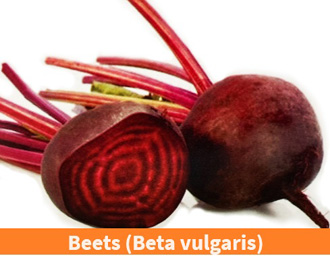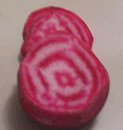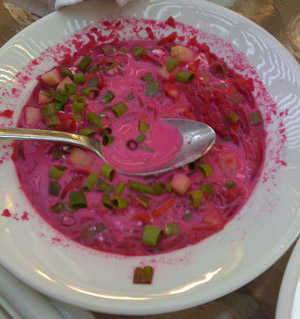Beets Nutrition facts
Beets are highly nutritious and “cardiovascular health” friendly root vegetables. Certain unique pigment antioxidants in this root and its top greens have been found to offer protection against coronary artery disease and stroke, lower cholesterol levels within the body, and have anti-aging effects.
Botanically, this tuberous root vegetable belongs to the Amaranthaceae family, in the beta genus. Its scientific name is Beta vulgaris. Swiss chard is another member of the beta genus grown for its edible leaves.
 |
| Beets (B. vulgaris). |
Beets are small herbaceous plants with broad dark-green leaves. Its underground taproot matures in 50-60 days of sowing and weighs about 100 to 150 grams. If not harvested at the right time, it continues growing to more than a pound and may develop surface cracks, woody and fibrous in texture, lose flavor, and become less appetizing.

|
| Chioggia beets- cut section.Courtesy: rochelle |
Many different cultivars like red, orange-yellow and white verities of beet exist. The unique crimson-red color of red beet is due to betalain pigments, such as betanin and betacyanin. Yellow varieties are rich in ß-xanthin pigment. The root and its top tender greens have been in use for human consumption. Chioggia beet or candy cane variety has alternative red and white concentric whorls.
Health benefits of Beets
Garden beet is very low in calories (provide only 45 kcal/100 g), contains zero cholesterol, and only a small amount of fat. Its nutrition benefits come particularly from fiber, vitamins, minerals, and unique plant-derived antioxidants.
Beetroot is a rich source of the phytochemical compound, glycine betaine. Betaine has the property of lowering homocysteine levels within the blood. Homocysteine, one of the highly toxic metabolites, promotes platelet clots as well as atherosclerotic plaque formation, which, otherwise, can be harmful to blood vessels. High levels of homocysteine in the blood result in the development of coronary heart disease (CHD), stroke, and peripheral vascular diseases.
Raw beets are an excellent source of folates. It contains about 109 µg/100 g of this vitamin (Provides 27% of RDA). However, extended cooking can significantly deplete its level of food. Folates are necessary for DNA synthesis within the cells. When given during the peri-conception period, folic acid can help prevent neural tube defects in newborns.
Fresh tubers contain small amounts of vitamin-C, however, its top greens are rather excellent sources of this vitamin. 100 g of beet greens provide 30 mg (50% of RDA). Vitamin C is one of the powerful natural antioxidants, which helps the human body scavenge harmful free radicals one of the reasons for cancer development.
Additionally, its top greens are an excellent source of carotenoids, flavonoid anti-oxidants, and vitamin A; contain these compounds several times more than that in the roots. Vitamin A is required to maintain healthy mucus membranes and skin and is essential for vision. Consumption of natural vegetables rich in flavonoids helps to protect from lung and oral cavity cancers.
The root is also a rich source of B-complex vitamins such as niacin (B-3), pantothenic acid (B-5), pyridoxine (B-6), and minerals such as iron, manganese, copper, and magnesium.
Further, the root is composed of moderate levels of potassium. 100 g fresh root holds 325 mg or 7% of daily requirements. Potassium lowers heart rate and regulates metabolism in the cells by countering the detrimental effects of sodium.
| Principle | Nutrient value | Percent of RDA |
|---|---|---|
| Energy | 43 cal | 2% |
| Carbohydrates | 9.56 g | 7% |
| Protein | 1.61 g | 1% |
| Total Fat | 0.17 g | 0.5% |
| Cholesterol | 0 mg | 0% |
| Dietary Fiber | 2.80 g | 7% |
| Vitamins | ||
| Folates | 109 µg | 27% |
| Niacin | 0.334 mg | 2% |
| Pantothenic acid | 0.155 mg | 3% |
| Pyridoxine | 0.067 mg | 5% |
| Riboflavin | 0.057 mg | 4% |
| Thiamin | 0.031 mg | 2.5% |
| Vitamin A | 33 IU | 1% |
| Vitamin C | 4.9 mg | 8% |
| Vitamin E | 0.04 mg | 0.5% |
| Vitamin K | 0.2 µg | 0% |
| Electrolytes | ||
| Sodium | 78 mg | 5% |
| Potassium | 325 mg | 7% |
| Minerals | ||
| Calcium | 16 mg | 1.5% |
| Copper | 0.075 mg | 8% |
| Iron | 0.80 mg | 10% |
| Magnesium | 23 mg | 6% |
| Manganese | 0.329 mg | 14% |
| Zinc | 0.35 mg | 3% |
| Phyto-nutrients | ||
| Carotene-ß | 20 µg | -- |
| Betaine | 128.7 mg | -- |
| Lutein-zeaxanthin | 0 µg | -- |
Selection and storage
In the stores, choose fresh, bright, firm-textured medium-size beets featuring healthy stems. Avoid soft, over-mature, and large beets as they are unappetizing. Whenever feasible, go for organic produce for rich flavor and extra nutritional benefits.
In the farmer's markets, beets are often available with their intact top greens. If you are looking to buy one, then separate its tops from the roots immediately because their top greens wean away moisture and nutrition from the roots.
Beet greens, just like other greens, should be washed thoroughly under clean, running water and rinsed in saline water for about 30 minutes to remove soil, sand, dirt, and any insecticide residues before use.
Top beet greens should be used while they are fresh. Beetroot, however, can be kept in the refrigerator set at high relative humidity for up to ten days.
Preparation
 |
| Borscht. Photo courtesy: ryancbore |
Besides its crispy root, fresh, tender top greens and stems are also very popular in the recipes.
To prepare, gently scrub and wash the roots in clean running water before use to remove sand, soil, and dirt. Peel the tough outer layer using a vegetable peeler. Cut the root into chunks, squares, or thin slices as you may desire.
Here are some serving tips:
Garden beets are being used in a variety of delicacies.
The root may be eaten raw in salads with carrot, radish, cucumber, cabbage, etc.
Steam the small cubes and serve warm with butter as a delicacy.
Pickled beets are a part of the traditional food in the southern American states.
-
Beet juice is a popular health drink.
In India, the roots are eaten boiled in curries with other vegetables such as carrot, potato, tomato,.
In Europe, cooked chunks are enjoyed as a side dish with added olive oil, vinegar, or lemon juice.
In Europe, cooked chunks are enjoyed as a side dish with added olive oil, vinegar, or lemon juice.
Betanin pigments, obtained from the plant parts, are being used in the food industry as colorants, e.g. to improve the color of tomato paste, sauces, desserts, jams and jellies, ice cream, sweets, etc.
Safety profile
Beeturia is a harmless condition of passing red or pink color urine after eating beets and its top greens. The condition is seen in around 10-15% of the populations who are genetically unable to break down betacyanin pigment.
Beet greens contain oxalic acid, a naturally occurring substance found in some vegetables, which may crystallize as oxalate stones in the urinary tract in some people. Therefore individuals with a known history of oxalate urinary tract stones are advised to avoid eating an excess of these greens. (Medical Disclaimer).
≻≻-Back to Vegetables from Beets nutrition. Visit here for an impressive list of vegetables with complete illustrations of their nutrition facts and health benefits.
≻≻-Read Beet greens nutrition facts.
≻≻-Back to Home page.
Further resources:
Refer Stanford School of Medicine Cancer information Page- Nutrition to Reduce Cancer Risk.
The American Journal of Clinical Nutrition-Betaine in Human nutrition.